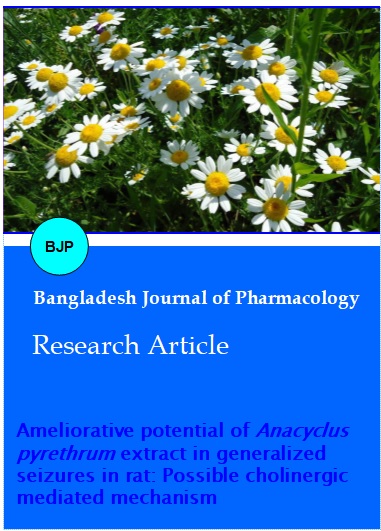Ameliorative potential of Anacyclus pyrethrum extract in generalized seizures in rat: Possible cholinergic mediated mechanism
DOI:
https://doi.org/10.3329/bjp.v14i4.40537Keywords:
Anacyclus pyrethrum, Atropine, Seizure, ScopolamineAbstract
The present study evaluates the anticonvulsant activity of the roots of Anacyclus pyrethrum using pilocarpine-induced experimental model of epilepsy in rat, and to determine its possible anticonvulsant mechanism. Ethanol extract (200 and 400 mg/kg) or alkylamides (25 and 50 mg/kg) was administered orally 45 min before the injection of pilocarpine-induced (400 mg/kg) seizures. The possible anticonvulsant mechanism was investigated by testing the effect of atropine (2 mL/kg) and scopolamine (1 mg/kg). The scoring of seizure severity, seizures time latency, duration of total seizures and percentage of mortality protection were recorded. Ethanol extract and alkylamides prolonged the time of onset seizure and decreased the duration of seizures compared to control group (p<0.001). The seizure protection was 100%. The co-administered of ethanol extract of A. pyrethrum and alkylamides with atropine completely abolished the pilocarpine-induced seizures.
Video Clip of Methodology:
Anticonvulsant effect: 6 min 7 sec: Click to watch
Downloads
218
150 Read
46

Published
How to Cite
Issue
Section
License
Authors who publish with this journal agree to the following terms:
- Authors retain copyright and grant the journal right of first publication with the work simultaneously licensed under a Creative Commons Attribution License that allows others to share the work with an acknowledgement of the work's authorship and initial publication in this journal.
- Authors are able to enter into separate, additional contractual arrangements for the non-exclusive distribution of the journal's published version of the work (e.g., post it to an institutional repository or publish it in a book), with an acknowledgement of its initial publication in this journal.
- Authors are permitted and encouraged to post their work online (e.g., in institutional repositories or on their website) prior to and during the submission process, as it can lead to productive exchanges, as well as earlier and greater citation of published work (See The Effect of Open Access).
